SBM3205 - Human Resource Management: Training and Development Report
VerifiedAdded on 2021/06/14
|10
|2536
|76
Report
AI Summary
This report delves into the critical role of training and development within Human Resource Management (HRM), emphasizing its significance in today's competitive business environment. It highlights how training and development programs contribute to enhancing employee skills, knowledge, and attitudes, ultimately improving individual and organizational performance. The report explores the various benefits of these programs, including addressing employee weaknesses, boosting performance, ensuring stability, and increasing job satisfaction. It also discusses the impact of change and development as key factors driving the need for continuous training. Furthermore, it provides insights into the training process and the advantages of integrating training and development initiatives to foster employee engagement and innovation. The report concludes by underscoring the essential role of training and development in equipping employees with the necessary skills to meet organizational goals and adapt to evolving industry demands.

Unit code: SBM3205
Unit name: Human Resource Management
Unit name: Human Resource Management
Paraphrase This Document
Need a fresh take? Get an instant paraphrase of this document with our AI Paraphraser
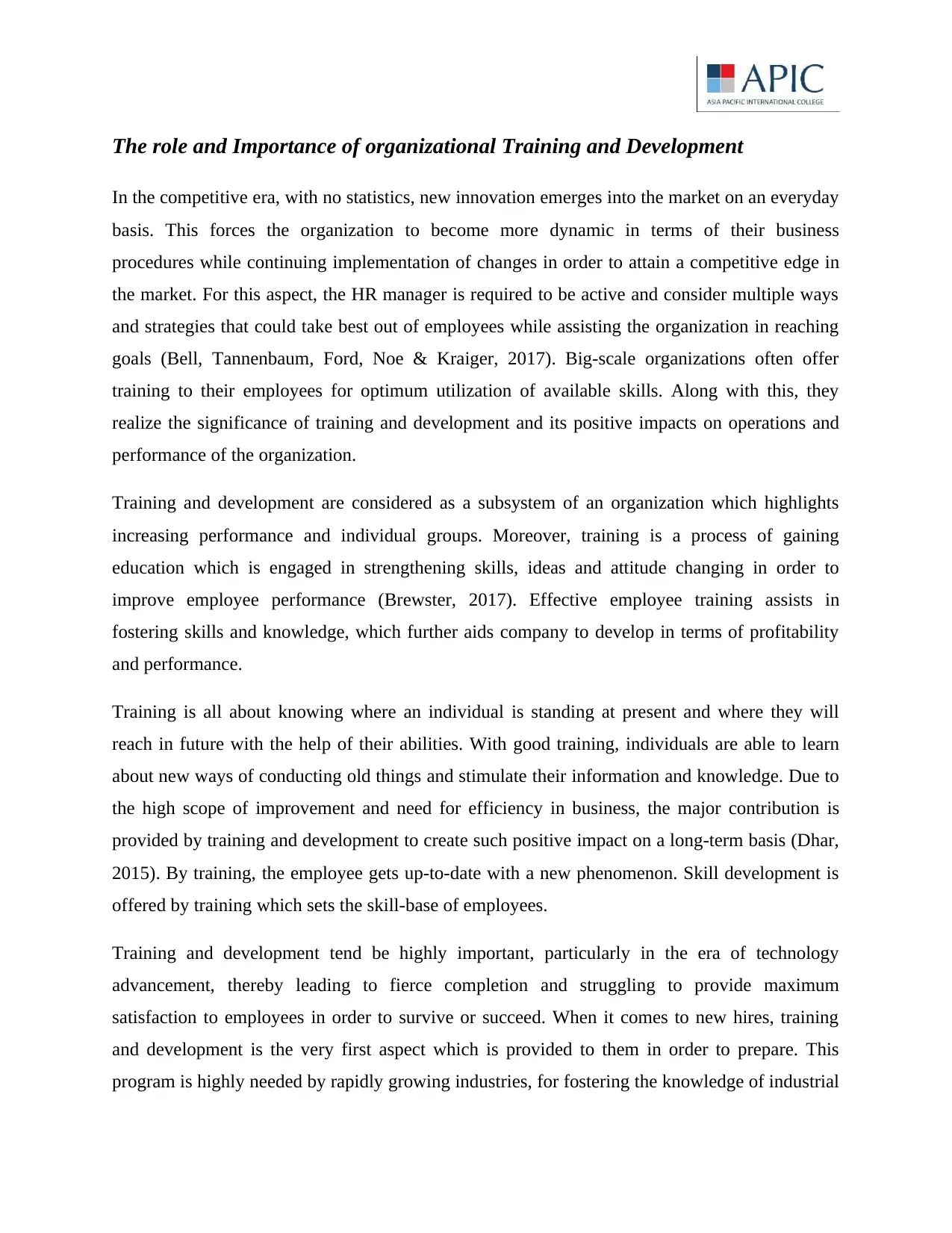
The role and Importance of organizational Training and Development
In the competitive era, with no statistics, new innovation emerges into the market on an everyday
basis. This forces the organization to become more dynamic in terms of their business
procedures while continuing implementation of changes in order to attain a competitive edge in
the market. For this aspect, the HR manager is required to be active and consider multiple ways
and strategies that could take best out of employees while assisting the organization in reaching
goals (Bell, Tannenbaum, Ford, Noe & Kraiger, 2017). Big-scale organizations often offer
training to their employees for optimum utilization of available skills. Along with this, they
realize the significance of training and development and its positive impacts on operations and
performance of the organization.
Training and development are considered as a subsystem of an organization which highlights
increasing performance and individual groups. Moreover, training is a process of gaining
education which is engaged in strengthening skills, ideas and attitude changing in order to
improve employee performance (Brewster, 2017). Effective employee training assists in
fostering skills and knowledge, which further aids company to develop in terms of profitability
and performance.
Training is all about knowing where an individual is standing at present and where they will
reach in future with the help of their abilities. With good training, individuals are able to learn
about new ways of conducting old things and stimulate their information and knowledge. Due to
the high scope of improvement and need for efficiency in business, the major contribution is
provided by training and development to create such positive impact on a long-term basis (Dhar,
2015). By training, the employee gets up-to-date with a new phenomenon. Skill development is
offered by training which sets the skill-base of employees.
Training and development tend be highly important, particularly in the era of technology
advancement, thereby leading to fierce completion and struggling to provide maximum
satisfaction to employees in order to survive or succeed. When it comes to new hires, training
and development is the very first aspect which is provided to them in order to prepare. This
program is highly needed by rapidly growing industries, for fostering the knowledge of industrial
In the competitive era, with no statistics, new innovation emerges into the market on an everyday
basis. This forces the organization to become more dynamic in terms of their business
procedures while continuing implementation of changes in order to attain a competitive edge in
the market. For this aspect, the HR manager is required to be active and consider multiple ways
and strategies that could take best out of employees while assisting the organization in reaching
goals (Bell, Tannenbaum, Ford, Noe & Kraiger, 2017). Big-scale organizations often offer
training to their employees for optimum utilization of available skills. Along with this, they
realize the significance of training and development and its positive impacts on operations and
performance of the organization.
Training and development are considered as a subsystem of an organization which highlights
increasing performance and individual groups. Moreover, training is a process of gaining
education which is engaged in strengthening skills, ideas and attitude changing in order to
improve employee performance (Brewster, 2017). Effective employee training assists in
fostering skills and knowledge, which further aids company to develop in terms of profitability
and performance.
Training is all about knowing where an individual is standing at present and where they will
reach in future with the help of their abilities. With good training, individuals are able to learn
about new ways of conducting old things and stimulate their information and knowledge. Due to
the high scope of improvement and need for efficiency in business, the major contribution is
provided by training and development to create such positive impact on a long-term basis (Dhar,
2015). By training, the employee gets up-to-date with a new phenomenon. Skill development is
offered by training which sets the skill-base of employees.
Training and development tend be highly important, particularly in the era of technology
advancement, thereby leading to fierce completion and struggling to provide maximum
satisfaction to employees in order to survive or succeed. When it comes to new hires, training
and development is the very first aspect which is provided to them in order to prepare. This
program is highly needed by rapidly growing industries, for fostering the knowledge of industrial
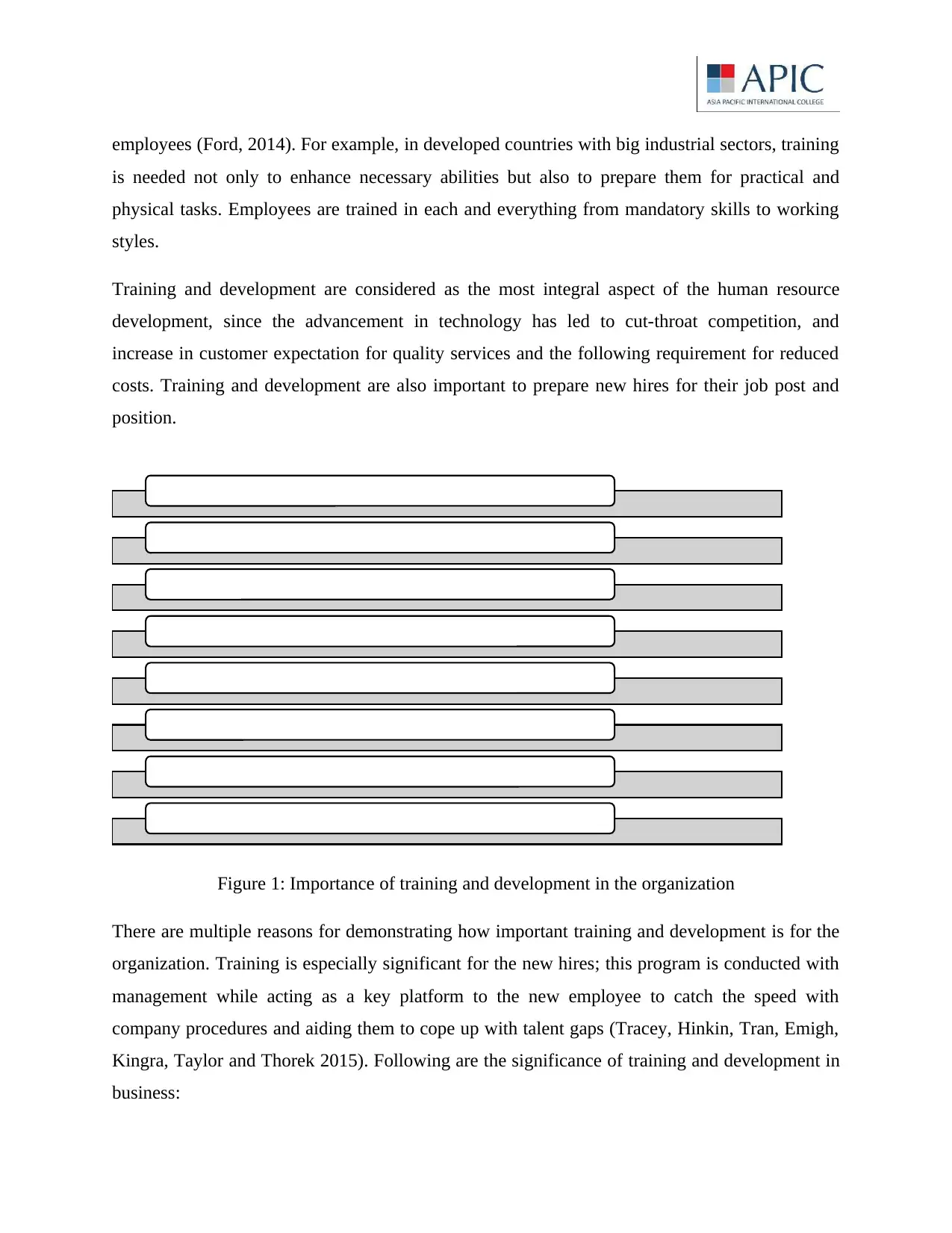
employees (Ford, 2014). For example, in developed countries with big industrial sectors, training
is needed not only to enhance necessary abilities but also to prepare them for practical and
physical tasks. Employees are trained in each and everything from mandatory skills to working
styles.
Training and development are considered as the most integral aspect of the human resource
development, since the advancement in technology has led to cut-throat competition, and
increase in customer expectation for quality services and the following requirement for reduced
costs. Training and development are also important to prepare new hires for their job post and
position.
Figure 1: Importance of training and development in the organization
There are multiple reasons for demonstrating how important training and development is for the
organization. Training is especially significant for the new hires; this program is conducted with
management while acting as a key platform to the new employee to catch the speed with
company procedures and aiding them to cope up with talent gaps (Tracey, Hinkin, Tran, Emigh,
Kingra, Taylor and Thorek 2015). Following are the significance of training and development in
business:
Optimum utilization of Human resources
Development of skills
To increase the productivity
To provide the zeal of team spirit
For improvement of organization culture
To improve quality, safety
To increase profitability
Improve the morale and corporate image
is needed not only to enhance necessary abilities but also to prepare them for practical and
physical tasks. Employees are trained in each and everything from mandatory skills to working
styles.
Training and development are considered as the most integral aspect of the human resource
development, since the advancement in technology has led to cut-throat competition, and
increase in customer expectation for quality services and the following requirement for reduced
costs. Training and development are also important to prepare new hires for their job post and
position.
Figure 1: Importance of training and development in the organization
There are multiple reasons for demonstrating how important training and development is for the
organization. Training is especially significant for the new hires; this program is conducted with
management while acting as a key platform to the new employee to catch the speed with
company procedures and aiding them to cope up with talent gaps (Tracey, Hinkin, Tran, Emigh,
Kingra, Taylor and Thorek 2015). Following are the significance of training and development in
business:
Optimum utilization of Human resources
Development of skills
To increase the productivity
To provide the zeal of team spirit
For improvement of organization culture
To improve quality, safety
To increase profitability
Improve the morale and corporate image
⊘ This is a preview!⊘
Do you want full access?
Subscribe today to unlock all pages.

Trusted by 1+ million students worldwide
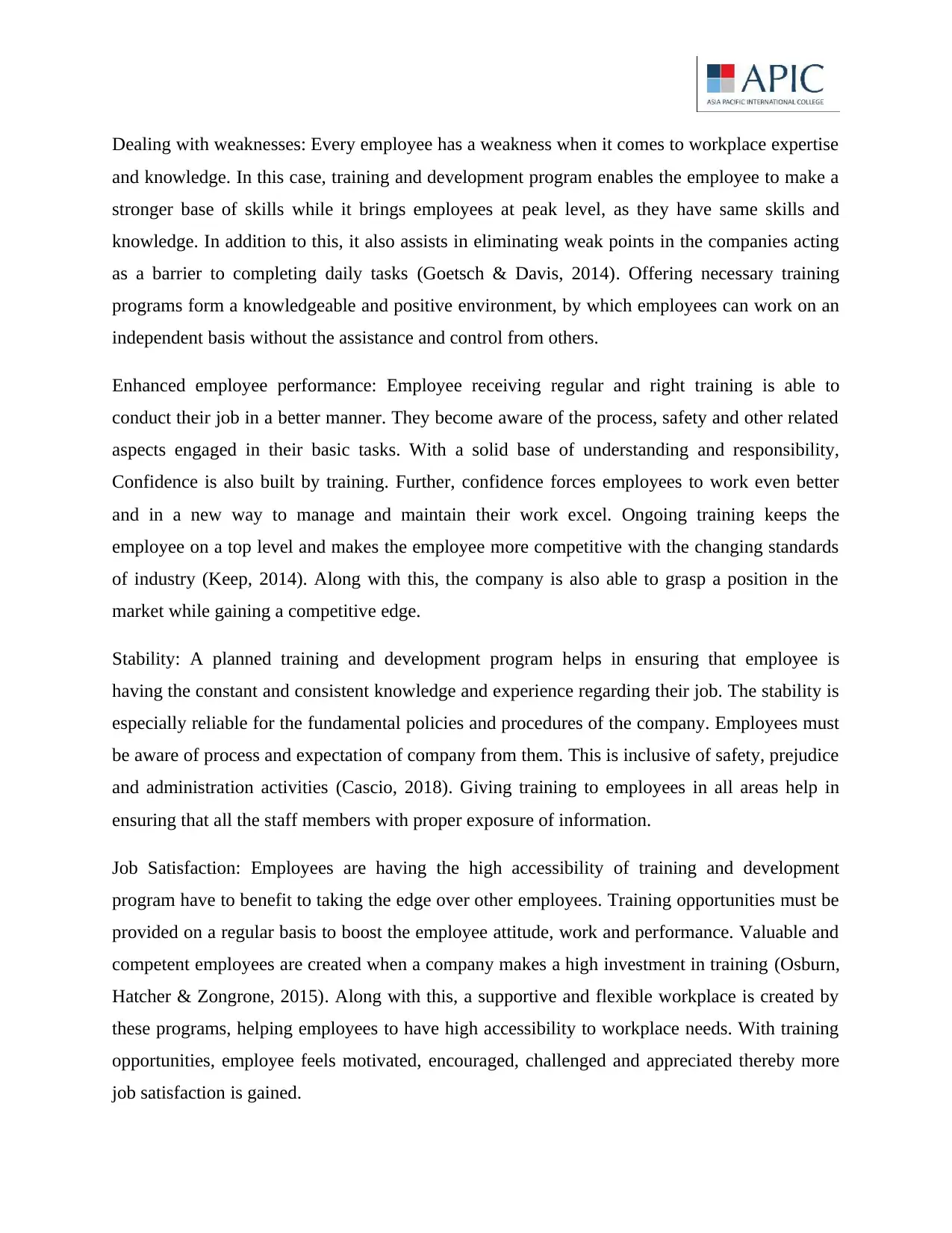
Dealing with weaknesses: Every employee has a weakness when it comes to workplace expertise
and knowledge. In this case, training and development program enables the employee to make a
stronger base of skills while it brings employees at peak level, as they have same skills and
knowledge. In addition to this, it also assists in eliminating weak points in the companies acting
as a barrier to completing daily tasks (Goetsch & Davis, 2014). Offering necessary training
programs form a knowledgeable and positive environment, by which employees can work on an
independent basis without the assistance and control from others.
Enhanced employee performance: Employee receiving regular and right training is able to
conduct their job in a better manner. They become aware of the process, safety and other related
aspects engaged in their basic tasks. With a solid base of understanding and responsibility,
Confidence is also built by training. Further, confidence forces employees to work even better
and in a new way to manage and maintain their work excel. Ongoing training keeps the
employee on a top level and makes the employee more competitive with the changing standards
of industry (Keep, 2014). Along with this, the company is also able to grasp a position in the
market while gaining a competitive edge.
Stability: A planned training and development program helps in ensuring that employee is
having the constant and consistent knowledge and experience regarding their job. The stability is
especially reliable for the fundamental policies and procedures of the company. Employees must
be aware of process and expectation of company from them. This is inclusive of safety, prejudice
and administration activities (Cascio, 2018). Giving training to employees in all areas help in
ensuring that all the staff members with proper exposure of information.
Job Satisfaction: Employees are having the high accessibility of training and development
program have to benefit to taking the edge over other employees. Training opportunities must be
provided on a regular basis to boost the employee attitude, work and performance. Valuable and
competent employees are created when a company makes a high investment in training (Osburn,
Hatcher & Zongrone, 2015). Along with this, a supportive and flexible workplace is created by
these programs, helping employees to have high accessibility to workplace needs. With training
opportunities, employee feels motivated, encouraged, challenged and appreciated thereby more
job satisfaction is gained.
and knowledge. In this case, training and development program enables the employee to make a
stronger base of skills while it brings employees at peak level, as they have same skills and
knowledge. In addition to this, it also assists in eliminating weak points in the companies acting
as a barrier to completing daily tasks (Goetsch & Davis, 2014). Offering necessary training
programs form a knowledgeable and positive environment, by which employees can work on an
independent basis without the assistance and control from others.
Enhanced employee performance: Employee receiving regular and right training is able to
conduct their job in a better manner. They become aware of the process, safety and other related
aspects engaged in their basic tasks. With a solid base of understanding and responsibility,
Confidence is also built by training. Further, confidence forces employees to work even better
and in a new way to manage and maintain their work excel. Ongoing training keeps the
employee on a top level and makes the employee more competitive with the changing standards
of industry (Keep, 2014). Along with this, the company is also able to grasp a position in the
market while gaining a competitive edge.
Stability: A planned training and development program helps in ensuring that employee is
having the constant and consistent knowledge and experience regarding their job. The stability is
especially reliable for the fundamental policies and procedures of the company. Employees must
be aware of process and expectation of company from them. This is inclusive of safety, prejudice
and administration activities (Cascio, 2018). Giving training to employees in all areas help in
ensuring that all the staff members with proper exposure of information.
Job Satisfaction: Employees are having the high accessibility of training and development
program have to benefit to taking the edge over other employees. Training opportunities must be
provided on a regular basis to boost the employee attitude, work and performance. Valuable and
competent employees are created when a company makes a high investment in training (Osburn,
Hatcher & Zongrone, 2015). Along with this, a supportive and flexible workplace is created by
these programs, helping employees to have high accessibility to workplace needs. With training
opportunities, employee feels motivated, encouraged, challenged and appreciated thereby more
job satisfaction is gained.
Paraphrase This Document
Need a fresh take? Get an instant paraphrase of this document with our AI Paraphraser
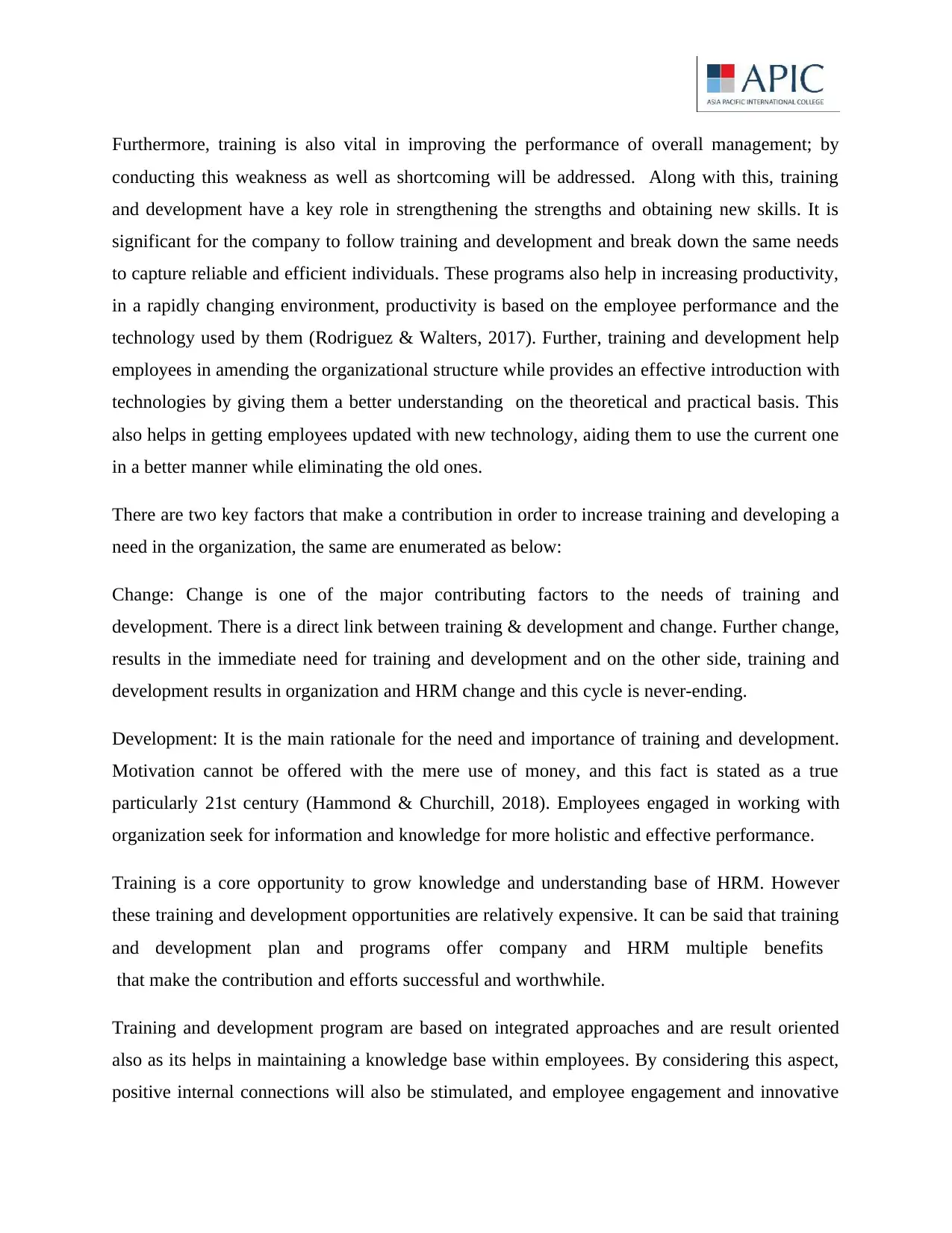
Furthermore, training is also vital in improving the performance of overall management; by
conducting this weakness as well as shortcoming will be addressed. Along with this, training
and development have a key role in strengthening the strengths and obtaining new skills. It is
significant for the company to follow training and development and break down the same needs
to capture reliable and efficient individuals. These programs also help in increasing productivity,
in a rapidly changing environment, productivity is based on the employee performance and the
technology used by them (Rodriguez & Walters, 2017). Further, training and development help
employees in amending the organizational structure while provides an effective introduction with
technologies by giving them a better understanding on the theoretical and practical basis. This
also helps in getting employees updated with new technology, aiding them to use the current one
in a better manner while eliminating the old ones.
There are two key factors that make a contribution in order to increase training and developing a
need in the organization, the same are enumerated as below:
Change: Change is one of the major contributing factors to the needs of training and
development. There is a direct link between training & development and change. Further change,
results in the immediate need for training and development and on the other side, training and
development results in organization and HRM change and this cycle is never-ending.
Development: It is the main rationale for the need and importance of training and development.
Motivation cannot be offered with the mere use of money, and this fact is stated as a true
particularly 21st century (Hammond & Churchill, 2018). Employees engaged in working with
organization seek for information and knowledge for more holistic and effective performance.
Training is a core opportunity to grow knowledge and understanding base of HRM. However
these training and development opportunities are relatively expensive. It can be said that training
and development plan and programs offer company and HRM multiple benefits
that make the contribution and efforts successful and worthwhile.
Training and development program are based on integrated approaches and are result oriented
also as its helps in maintaining a knowledge base within employees. By considering this aspect,
positive internal connections will also be stimulated, and employee engagement and innovative
conducting this weakness as well as shortcoming will be addressed. Along with this, training
and development have a key role in strengthening the strengths and obtaining new skills. It is
significant for the company to follow training and development and break down the same needs
to capture reliable and efficient individuals. These programs also help in increasing productivity,
in a rapidly changing environment, productivity is based on the employee performance and the
technology used by them (Rodriguez & Walters, 2017). Further, training and development help
employees in amending the organizational structure while provides an effective introduction with
technologies by giving them a better understanding on the theoretical and practical basis. This
also helps in getting employees updated with new technology, aiding them to use the current one
in a better manner while eliminating the old ones.
There are two key factors that make a contribution in order to increase training and developing a
need in the organization, the same are enumerated as below:
Change: Change is one of the major contributing factors to the needs of training and
development. There is a direct link between training & development and change. Further change,
results in the immediate need for training and development and on the other side, training and
development results in organization and HRM change and this cycle is never-ending.
Development: It is the main rationale for the need and importance of training and development.
Motivation cannot be offered with the mere use of money, and this fact is stated as a true
particularly 21st century (Hammond & Churchill, 2018). Employees engaged in working with
organization seek for information and knowledge for more holistic and effective performance.
Training is a core opportunity to grow knowledge and understanding base of HRM. However
these training and development opportunities are relatively expensive. It can be said that training
and development plan and programs offer company and HRM multiple benefits
that make the contribution and efforts successful and worthwhile.
Training and development program are based on integrated approaches and are result oriented
also as its helps in maintaining a knowledge base within employees. By considering this aspect,
positive internal connections will also be stimulated, and employee engagement and innovative
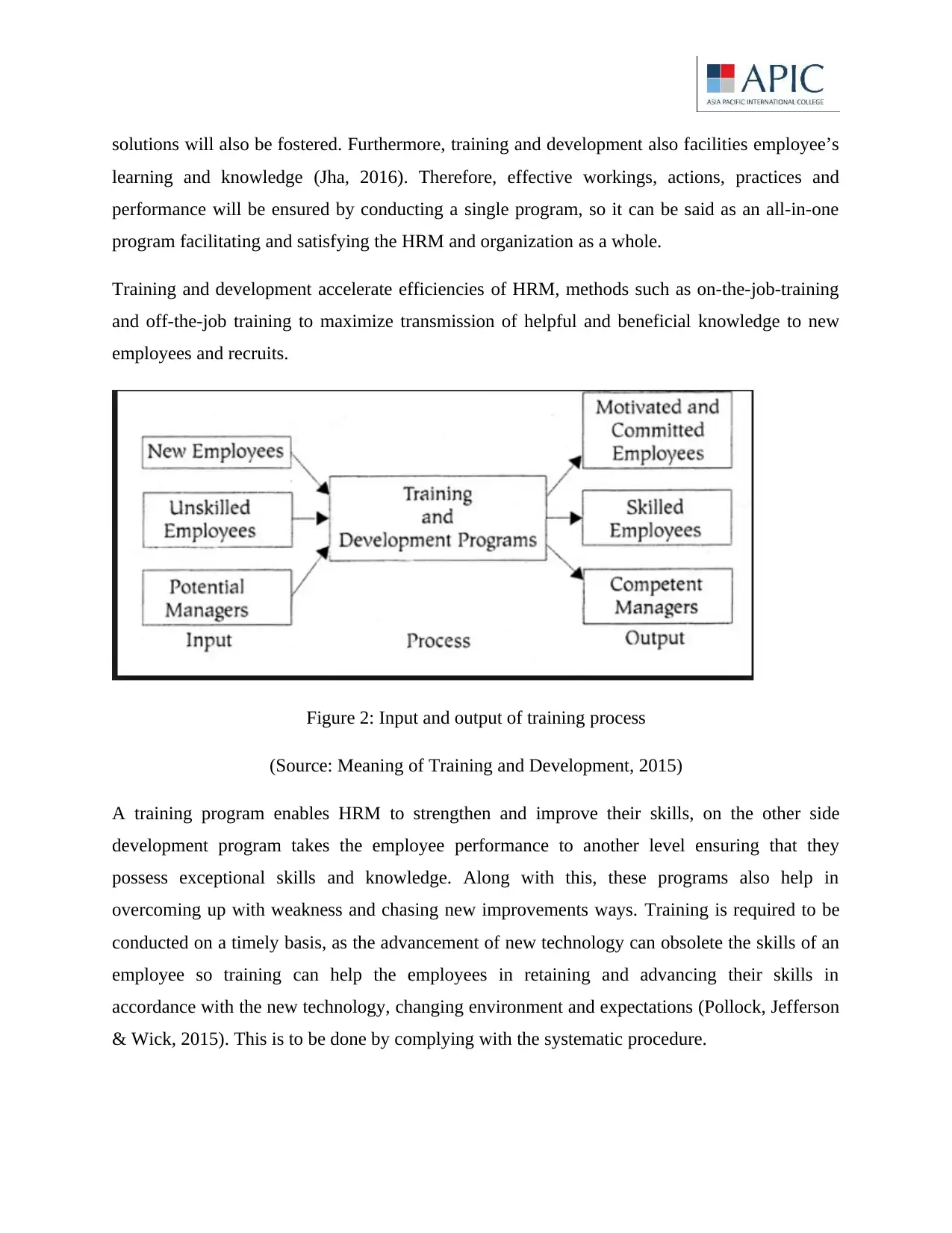
solutions will also be fostered. Furthermore, training and development also facilities employee’s
learning and knowledge (Jha, 2016). Therefore, effective workings, actions, practices and
performance will be ensured by conducting a single program, so it can be said as an all-in-one
program facilitating and satisfying the HRM and organization as a whole.
Training and development accelerate efficiencies of HRM, methods such as on-the-job-training
and off-the-job training to maximize transmission of helpful and beneficial knowledge to new
employees and recruits.
Figure 2: Input and output of training process
(Source: Meaning of Training and Development, 2015)
A training program enables HRM to strengthen and improve their skills, on the other side
development program takes the employee performance to another level ensuring that they
possess exceptional skills and knowledge. Along with this, these programs also help in
overcoming up with weakness and chasing new improvements ways. Training is required to be
conducted on a timely basis, as the advancement of new technology can obsolete the skills of an
employee so training can help the employees in retaining and advancing their skills in
accordance with the new technology, changing environment and expectations (Pollock, Jefferson
& Wick, 2015). This is to be done by complying with the systematic procedure.
learning and knowledge (Jha, 2016). Therefore, effective workings, actions, practices and
performance will be ensured by conducting a single program, so it can be said as an all-in-one
program facilitating and satisfying the HRM and organization as a whole.
Training and development accelerate efficiencies of HRM, methods such as on-the-job-training
and off-the-job training to maximize transmission of helpful and beneficial knowledge to new
employees and recruits.
Figure 2: Input and output of training process
(Source: Meaning of Training and Development, 2015)
A training program enables HRM to strengthen and improve their skills, on the other side
development program takes the employee performance to another level ensuring that they
possess exceptional skills and knowledge. Along with this, these programs also help in
overcoming up with weakness and chasing new improvements ways. Training is required to be
conducted on a timely basis, as the advancement of new technology can obsolete the skills of an
employee so training can help the employees in retaining and advancing their skills in
accordance with the new technology, changing environment and expectations (Pollock, Jefferson
& Wick, 2015). This is to be done by complying with the systematic procedure.
⊘ This is a preview!⊘
Do you want full access?
Subscribe today to unlock all pages.

Trusted by 1+ million students worldwide
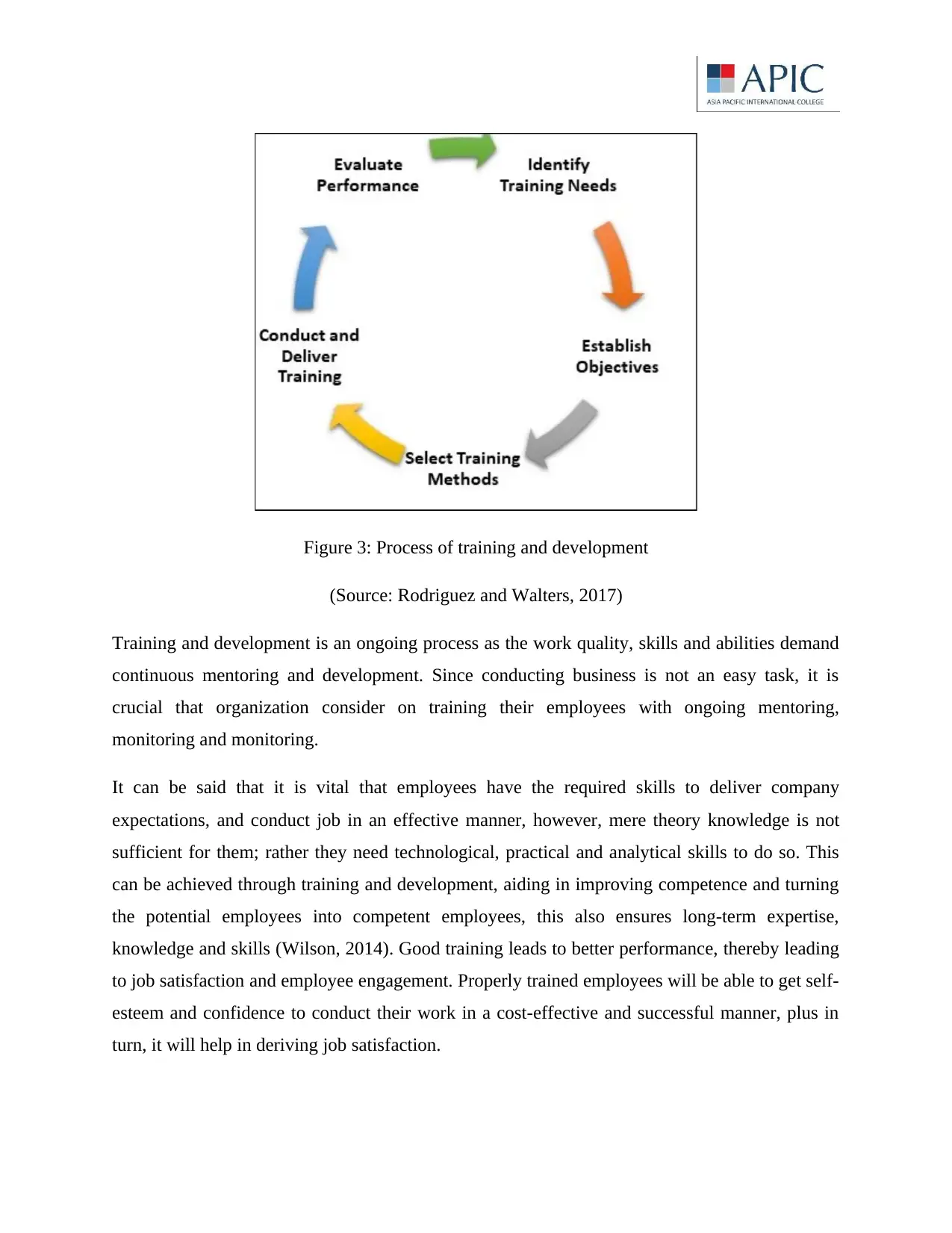
Figure 3: Process of training and development
(Source: Rodriguez and Walters, 2017)
Training and development is an ongoing process as the work quality, skills and abilities demand
continuous mentoring and development. Since conducting business is not an easy task, it is
crucial that organization consider on training their employees with ongoing mentoring,
monitoring and monitoring.
It can be said that it is vital that employees have the required skills to deliver company
expectations, and conduct job in an effective manner, however, mere theory knowledge is not
sufficient for them; rather they need technological, practical and analytical skills to do so. This
can be achieved through training and development, aiding in improving competence and turning
the potential employees into competent employees, this also ensures long-term expertise,
knowledge and skills (Wilson, 2014). Good training leads to better performance, thereby leading
to job satisfaction and employee engagement. Properly trained employees will be able to get self-
esteem and confidence to conduct their work in a cost-effective and successful manner, plus in
turn, it will help in deriving job satisfaction.
(Source: Rodriguez and Walters, 2017)
Training and development is an ongoing process as the work quality, skills and abilities demand
continuous mentoring and development. Since conducting business is not an easy task, it is
crucial that organization consider on training their employees with ongoing mentoring,
monitoring and monitoring.
It can be said that it is vital that employees have the required skills to deliver company
expectations, and conduct job in an effective manner, however, mere theory knowledge is not
sufficient for them; rather they need technological, practical and analytical skills to do so. This
can be achieved through training and development, aiding in improving competence and turning
the potential employees into competent employees, this also ensures long-term expertise,
knowledge and skills (Wilson, 2014). Good training leads to better performance, thereby leading
to job satisfaction and employee engagement. Properly trained employees will be able to get self-
esteem and confidence to conduct their work in a cost-effective and successful manner, plus in
turn, it will help in deriving job satisfaction.
Paraphrase This Document
Need a fresh take? Get an instant paraphrase of this document with our AI Paraphraser
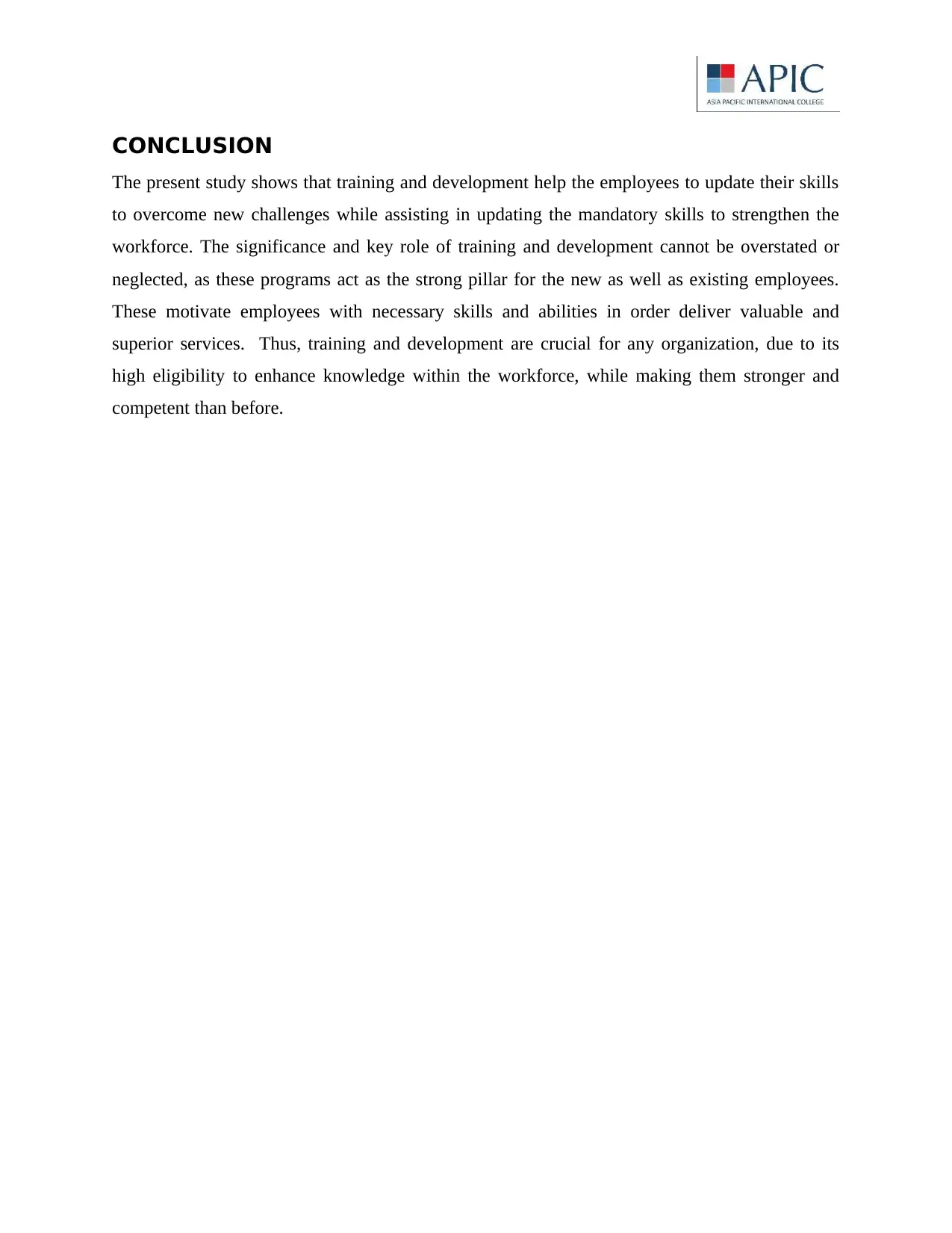
CONCLUSION
The present study shows that training and development help the employees to update their skills
to overcome new challenges while assisting in updating the mandatory skills to strengthen the
workforce. The significance and key role of training and development cannot be overstated or
neglected, as these programs act as the strong pillar for the new as well as existing employees.
These motivate employees with necessary skills and abilities in order deliver valuable and
superior services. Thus, training and development are crucial for any organization, due to its
high eligibility to enhance knowledge within the workforce, while making them stronger and
competent than before.
The present study shows that training and development help the employees to update their skills
to overcome new challenges while assisting in updating the mandatory skills to strengthen the
workforce. The significance and key role of training and development cannot be overstated or
neglected, as these programs act as the strong pillar for the new as well as existing employees.
These motivate employees with necessary skills and abilities in order deliver valuable and
superior services. Thus, training and development are crucial for any organization, due to its
high eligibility to enhance knowledge within the workforce, while making them stronger and
competent than before.
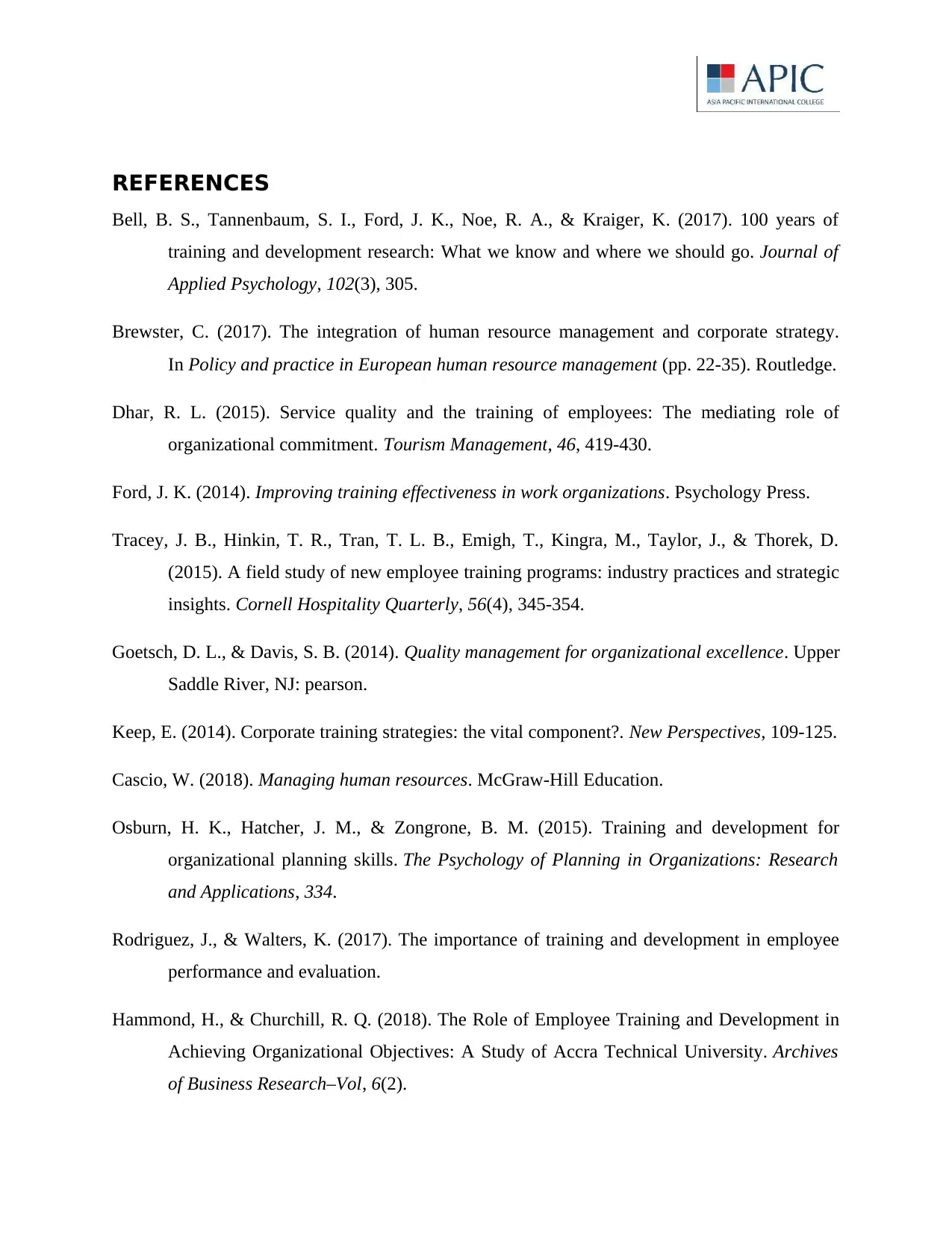
REFERENCES
Bell, B. S., Tannenbaum, S. I., Ford, J. K., Noe, R. A., & Kraiger, K. (2017). 100 years of
training and development research: What we know and where we should go. Journal of
Applied Psychology, 102(3), 305.
Brewster, C. (2017). The integration of human resource management and corporate strategy.
In Policy and practice in European human resource management (pp. 22-35). Routledge.
Dhar, R. L. (2015). Service quality and the training of employees: The mediating role of
organizational commitment. Tourism Management, 46, 419-430.
Ford, J. K. (2014). Improving training effectiveness in work organizations. Psychology Press.
Tracey, J. B., Hinkin, T. R., Tran, T. L. B., Emigh, T., Kingra, M., Taylor, J., & Thorek, D.
(2015). A field study of new employee training programs: industry practices and strategic
insights. Cornell Hospitality Quarterly, 56(4), 345-354.
Goetsch, D. L., & Davis, S. B. (2014). Quality management for organizational excellence. Upper
Saddle River, NJ: pearson.
Keep, E. (2014). Corporate training strategies: the vital component?. New Perspectives, 109-125.
Cascio, W. (2018). Managing human resources. McGraw-Hill Education.
Osburn, H. K., Hatcher, J. M., & Zongrone, B. M. (2015). Training and development for
organizational planning skills. The Psychology of Planning in Organizations: Research
and Applications, 334.
Rodriguez, J., & Walters, K. (2017). The importance of training and development in employee
performance and evaluation.
Hammond, H., & Churchill, R. Q. (2018). The Role of Employee Training and Development in
Achieving Organizational Objectives: A Study of Accra Technical University. Archives
of Business Research–Vol, 6(2).
Bell, B. S., Tannenbaum, S. I., Ford, J. K., Noe, R. A., & Kraiger, K. (2017). 100 years of
training and development research: What we know and where we should go. Journal of
Applied Psychology, 102(3), 305.
Brewster, C. (2017). The integration of human resource management and corporate strategy.
In Policy and practice in European human resource management (pp. 22-35). Routledge.
Dhar, R. L. (2015). Service quality and the training of employees: The mediating role of
organizational commitment. Tourism Management, 46, 419-430.
Ford, J. K. (2014). Improving training effectiveness in work organizations. Psychology Press.
Tracey, J. B., Hinkin, T. R., Tran, T. L. B., Emigh, T., Kingra, M., Taylor, J., & Thorek, D.
(2015). A field study of new employee training programs: industry practices and strategic
insights. Cornell Hospitality Quarterly, 56(4), 345-354.
Goetsch, D. L., & Davis, S. B. (2014). Quality management for organizational excellence. Upper
Saddle River, NJ: pearson.
Keep, E. (2014). Corporate training strategies: the vital component?. New Perspectives, 109-125.
Cascio, W. (2018). Managing human resources. McGraw-Hill Education.
Osburn, H. K., Hatcher, J. M., & Zongrone, B. M. (2015). Training and development for
organizational planning skills. The Psychology of Planning in Organizations: Research
and Applications, 334.
Rodriguez, J., & Walters, K. (2017). The importance of training and development in employee
performance and evaluation.
Hammond, H., & Churchill, R. Q. (2018). The Role of Employee Training and Development in
Achieving Organizational Objectives: A Study of Accra Technical University. Archives
of Business Research–Vol, 6(2).
⊘ This is a preview!⊘
Do you want full access?
Subscribe today to unlock all pages.

Trusted by 1+ million students worldwide
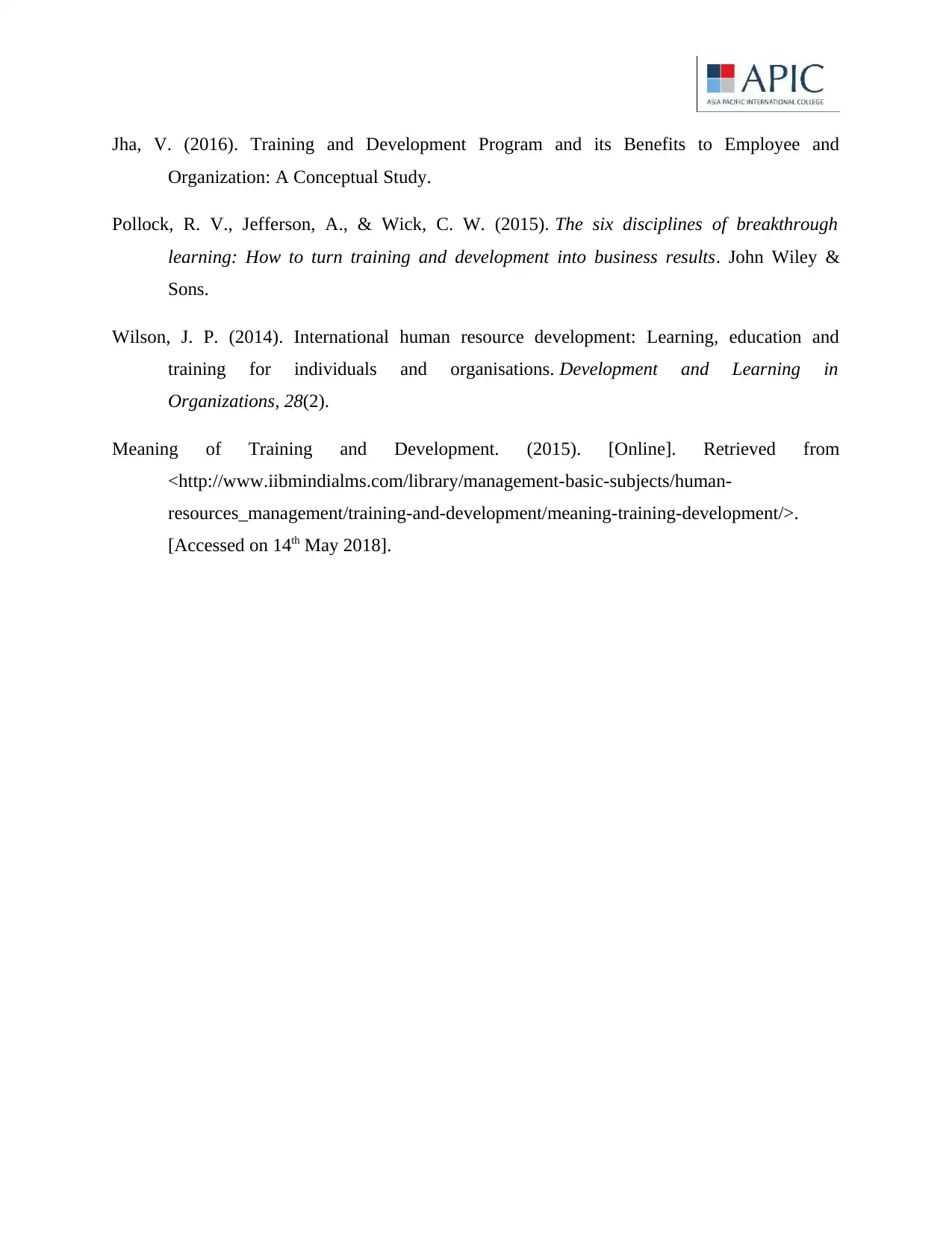
Jha, V. (2016). Training and Development Program and its Benefits to Employee and
Organization: A Conceptual Study.
Pollock, R. V., Jefferson, A., & Wick, C. W. (2015). The six disciplines of breakthrough
learning: How to turn training and development into business results. John Wiley &
Sons.
Wilson, J. P. (2014). International human resource development: Learning, education and
training for individuals and organisations. Development and Learning in
Organizations, 28(2).
Meaning of Training and Development. (2015). [Online]. Retrieved from
<http://www.iibmindialms.com/library/management-basic-subjects/human-
resources_management/training-and-development/meaning-training-development/>.
[Accessed on 14th May 2018].
Organization: A Conceptual Study.
Pollock, R. V., Jefferson, A., & Wick, C. W. (2015). The six disciplines of breakthrough
learning: How to turn training and development into business results. John Wiley &
Sons.
Wilson, J. P. (2014). International human resource development: Learning, education and
training for individuals and organisations. Development and Learning in
Organizations, 28(2).
Meaning of Training and Development. (2015). [Online]. Retrieved from
<http://www.iibmindialms.com/library/management-basic-subjects/human-
resources_management/training-and-development/meaning-training-development/>.
[Accessed on 14th May 2018].
1 out of 10
Related Documents
Your All-in-One AI-Powered Toolkit for Academic Success.
+13062052269
info@desklib.com
Available 24*7 on WhatsApp / Email
![[object Object]](/_next/static/media/star-bottom.7253800d.svg)
Unlock your academic potential
Copyright © 2020–2025 A2Z Services. All Rights Reserved. Developed and managed by ZUCOL.




